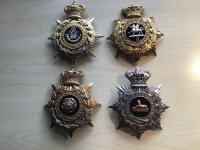chinstrap
Active member
This may have been discussed before, but how were wappen shaped to fit closely and tightly to the curvature of helmets, given there were so many variations in size, manufacturer etc? Were they flat when produced?
I am trying to find answers to the same questions about the officer helmet plates fitted to the British home service helmets I collect. These plates are more substantial than wappens and very difficult to shape, yet the curvature on all the plates I have varies dramatically. Some examples of what these plates look like below-not a great photo, I’m afraid
Patrick
I am trying to find answers to the same questions about the officer helmet plates fitted to the British home service helmets I collect. These plates are more substantial than wappens and very difficult to shape, yet the curvature on all the plates I have varies dramatically. Some examples of what these plates look like below-not a great photo, I’m afraid
Patrick

Last edited:

